NHRA, RACERS DISCUSS TETHERING OPT-OUT SITUATION
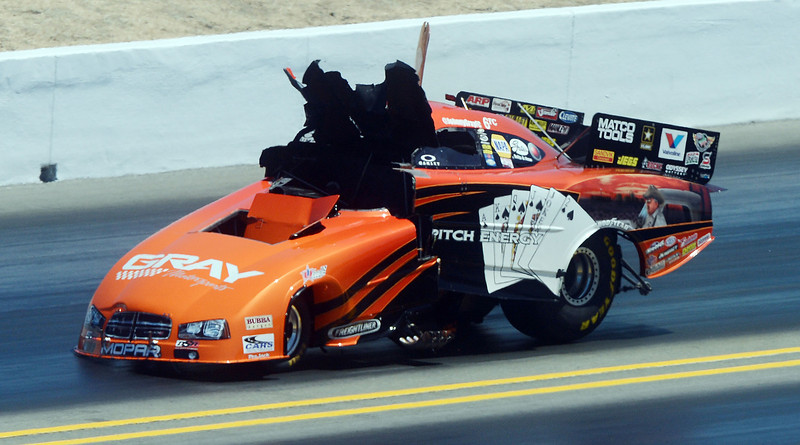 A week of angry reaction to the latch and tethering system for Funny Car bodies following Johnny Gray's engine explosion last Sunday at Sonoma ended with a victory for the vocal drivers who argued for its removal.
A week of angry reaction to the latch and tethering system for Funny Car bodies following Johnny Gray's engine explosion last Sunday at Sonoma ended with a victory for the vocal drivers who argued for its removal.
But the way Funny Car owner-driver Tim Wilkerson saw it, NHRA's decision to downgrade the system from mandatory to optional, starting with the O'Reilly Northwest Nationals at Seattle, Friday's ruling was a win-win situation.
Johnny Gray and those who understood his claim that the system endangered his life rather than serving as a safety device naturally felt victorious. But Wilkerson, who agreed with Gray's charges, also said the NHRA won in this matter, too, for it made a virtually unprecedented concession.
And that meant success, if only in a small way so far, he said, because it meant both racers and the sanctioning body are learning to listen to each other and talk through problems rather than become exasperated with each other and perpetuate the problems and mistrust.
 A week of angry reaction to the latch and tethering system for Funny Car bodies following Johnny Gray's engine explosion last Sunday at Sonoma ended with a victory for the vocal drivers who argued for its removal.
A week of angry reaction to the latch and tethering system for Funny Car bodies following Johnny Gray's engine explosion last Sunday at Sonoma ended with a victory for the vocal drivers who argued for its removal.
But the way Funny Car owner-driver Tim Wilkerson saw it, NHRA's decision to downgrade the system from mandatory to optional, starting with the O'Reilly Northwest Nationals at Seattle, Friday's ruling was a win-win situation.
Johnny Gray and those who understood his claim that the system endangered his life rather than serving as a safety device naturally felt victorious. But Wilkerson, who agreed with Gray's charges, also said the NHRA won in this matter, too, for it made a virtually unprecedented concession.
And that meant success, if only in a small way so far, he said, because it meant both racers and the sanctioning body are learning to listen to each other and talk through problems rather than become exasperated with each other and perpetuate the problems and mistrust.
Glen Gray, NHRA's vice-president of technical operations, agreed.
"We really all are working well as a team," Gray said. "Ideas are being kicked around and discussed. There are lots of cause-and-effect scenarios discussed. It's not just NHRA. It's a group of some of the smartest people out here with respect to these bodies and cars. I believe we are going to come up with a good solution to this."
Both sides met Friday at Pacific Raceways, where rain forced cancellation of the pro qualifying sessions. But the racers and NHRA made progress off the track.
Key to understanding the issue is taking a look back to the Four-Wide Nationals in April at Charlotte. That's where the Funny Car body of driver Robert Hight blew off the car, sailed through the air, and landed in the grandstands. A couple of fans received minor injuries.
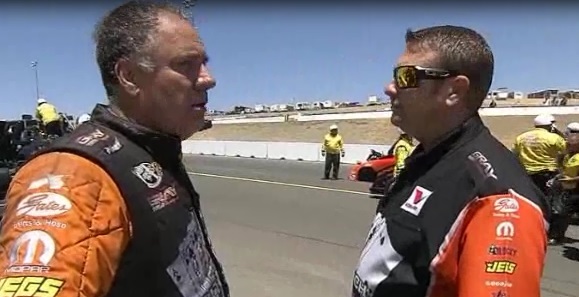 Johnny Gray and xrew chief Rob Wendland have been the most outspoken critics on the thethering system.So the NHRA began to devise ways to keep the bodies on the chassis in case of powerful engine concussions. They determined that dual latches (rather than one) and a tethering system would keep the bodies from separating and possibly landing in the stands again.
Johnny Gray and xrew chief Rob Wendland have been the most outspoken critics on the thethering system.So the NHRA began to devise ways to keep the bodies on the chassis in case of powerful engine concussions. They determined that dual latches (rather than one) and a tethering system would keep the bodies from separating and possibly landing in the stands again.
Johnny Gray's incident at Sonoma proved that the body indeed will stay on with this new system.
However, a number of problems resulted from the body remaining on the car. Different kinds of race cars are engineered to break apart in case of a serious accident so the energy disperses, or scatters, rather than having the driver absorb the impact. While that shrapnel might look spectacularly wicked, it actually means the car is doing its job of protecting the driver by relieving pressure inside the cockpit.
However, in Johnny Gray's case, the closed body kept the impact of the engine blast inside his Pitch Energy Dodge Charger with a mighty force that he said "all but knocked me out" and left him feeling "like a like a 350-pound lineman ran over me."
The body split in two, shoved the firewall up in front of and across the windshield, and obstructed his vision. Gray couldn't see where he was driving and had a hard time stopping the car, ultimately hitting the wall. The abuse the car's body took caused it to shift from its proper position, making it even more difficult for Gray to find his way out of the car as it continued to burn.
Among Gray's criticisms was that the NHRA mandated the use of the dual latches and tethering system before it fully had researched, tested, and/or engineered the equipment and its effects. And he called for the sanctioning body to rescind its mandate before a driver is killed in another such incident.
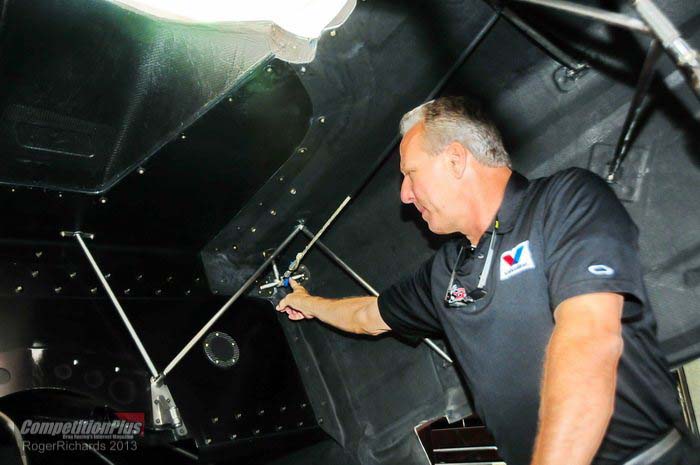 The tethering system as pointed out by crewchief Todd Smith was implemented in Denver and this weekend has been made optional. That prompted a meeting among NHRA officials and the racing teams, out of which came the relaxation of the rule. While it might not be a complete admission of poor or hasty judgment on its own part, the NHRA nevertheless gave the racers permission (at least for the foreseeable future) to remove the tethers from their cars, beginning this weekend.
The tethering system as pointed out by crewchief Todd Smith was implemented in Denver and this weekend has been made optional. That prompted a meeting among NHRA officials and the racing teams, out of which came the relaxation of the rule. While it might not be a complete admission of poor or hasty judgment on its own part, the NHRA nevertheless gave the racers permission (at least for the foreseeable future) to remove the tethers from their cars, beginning this weekend.
Glen Gray also told Competition Plus that the NHRA is considering side burst panels, as suggested by Johnny Gray's crew chief, Rob Wendland. He said the NHRA is not only considering side panels but also bigger panels and or even smaller ones to replace the large units.
Wendland had lobbied for that change before the tethering system became mandatory, and he reiterated his idea immediately following the crash at Sonoma.
According to Glen Gray, "We didn't try to implement it because it is very difficult to do in the middle of a race season. This would require a trip back to the body manufacturer, and this wouldn't be practical during the season."
He said, "We have been trying to develop ways we could put in more burst panels or bigger burst panels to alleviate the pressure. Until we can resolve some of these tether issues, they will be optional."
Glen Gray told Competition Plus that what happened in Johnny Gray's incident involved a part of the car called the "saddle." It's the hook which holds the back of the body in place. He said, "The rear of the car came out of the saddle. He said that "was something we couldn’t foresee happening. The rear of the car came out of the saddle. This is where the rear of the body attaches. It popped out of there, allowing the body to move 10 inches during the crash.
"That's why Johnny had trouble getting out of the car. The opening in the Funny Car body was not lined up with the cage. He had to move 10 inches in the other direction, which made it harder for him to get out.”
Gray said a "tether focus group" will work on finding a better design for the saddle. He did not name members of the focus group.
"It really needs to be redesigned," Glen Gray said of the saddle. "This needs to be done before we can reconsider putting these tethers back on."
Gray also confirmed the NHRA and the focus group plan to investigate better ways of releasing pressure from underneath the bodies in cases of an explosion.
"We need to keep these bodies from splitting in the first place," Glen Gray said. "This has always been part of the project but was in our Phase Two portion."
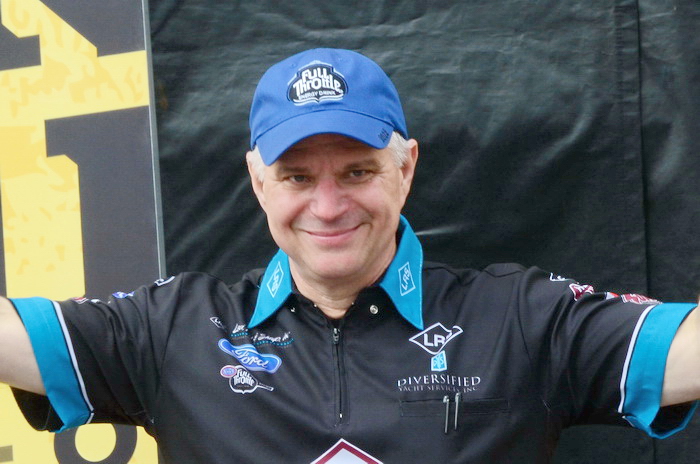 The way Funny Car owner-driver Tim Wilkerson sees it, NHRA's decision to downgrade the system from mandatory to optional, starting with the O'Reilly Northwest Nationals at Seattle, Friday's ruling is a win-win situation.It's unclear why a Phase Two -- when it concerns so critical a matter as keeping the body in one piece -- was left incomplete when the latch-and-tether system was implemented.
The way Funny Car owner-driver Tim Wilkerson sees it, NHRA's decision to downgrade the system from mandatory to optional, starting with the O'Reilly Northwest Nationals at Seattle, Friday's ruling is a win-win situation.It's unclear why a Phase Two -- when it concerns so critical a matter as keeping the body in one piece -- was left incomplete when the latch-and-tether system was implemented.
"We have been trying to develop ways we could put in more burst panels or bigger burst panels to alleviate the pressure. Until we can resolve some of these tether issues, they will be optional."
Incidentally, the same day that Johnny Gray had his experience, Courtney Force’s Mustang Funny Car launched a burst panel into the air.
"Over the last four or five years," Glen Gray said, "we’ve done a lot to restrain those burst panels."
He said he hasn't determined yet what went wrong in Force’s situation because of the attention the Johnny Gray incident drew.
"We have some pretty strong tethers in place [on the burst panel]," the NHRA official said. "We're unsure if something else failed which allowed the burst panel to fly into the air. We’re going to look into that, because it wasn’t supposed to happen. Something else in the mechanism had to fail that we need to handle, and correct."
Gray said Hight's body-launch incident at zMAX Dragway was the result of a body latch failure. Such a failure, he said, was one of two problems he and the NHRA wanted to address with the latching and tethering system.
"There were really two aspects to what we were trying to fix," Glen Gray said. "One was the latch failure, when the body leaves intact, like Robert's did, as one big piece. Most don't go a long distance. But when they do, this is something we don't want to see. We obviously want to keep that stuff on the racing surface and prevent it from going over the wall."
He said the NHRA gathered representatives from each race team to discuss options following the Hight incident in April.
The double latching system, Glen Gray said, is something for which he received overwhelming support from the majority of teams he spoke with.
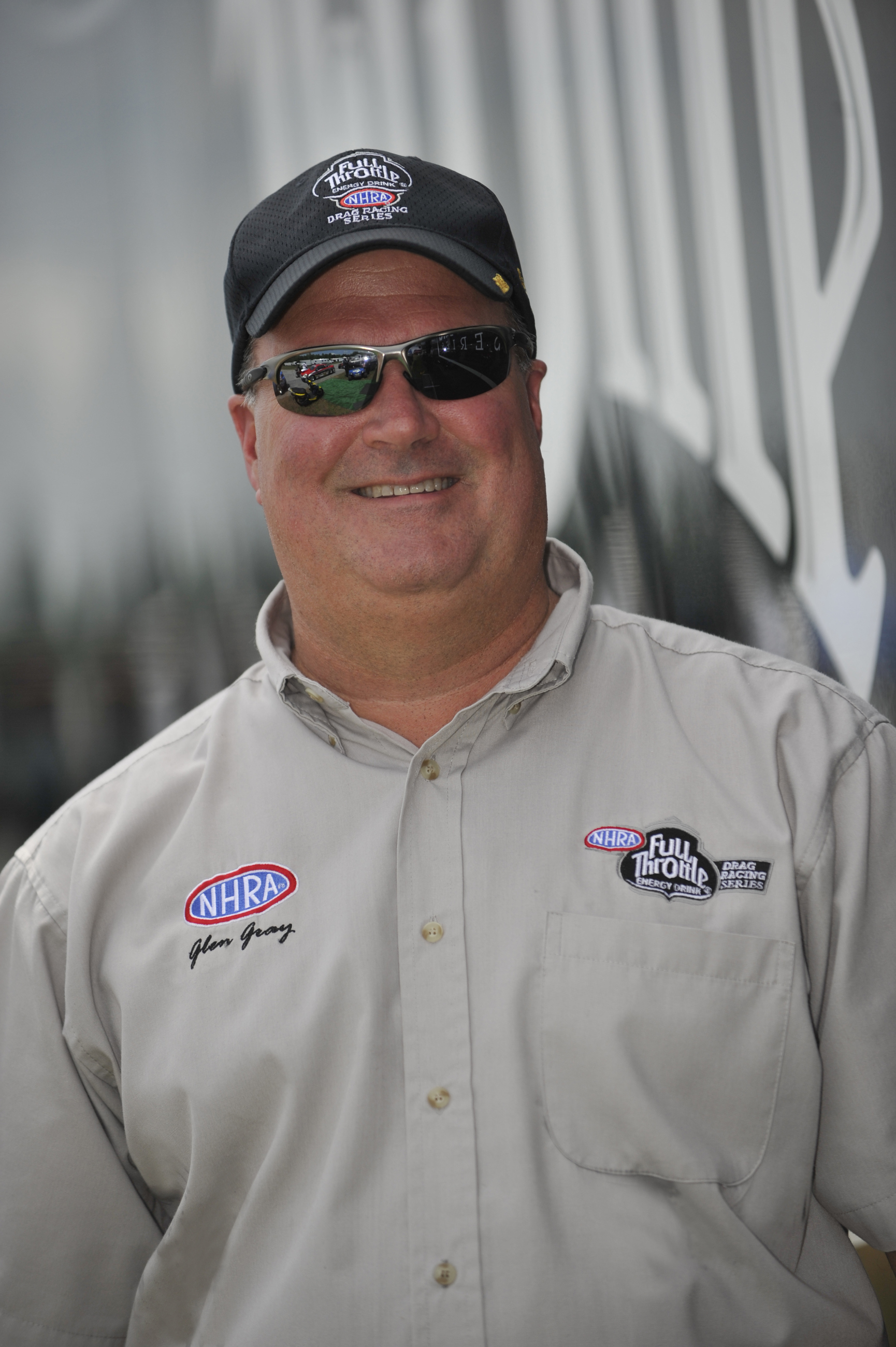 Glen Gray said the NHRA did get input on the tethering system before it was implemented. He said each team was represented. For example, Mike Neff was John Force Racing's original representative but stepped aside for one of their engineers and a fabricator. Todd Okuhara originally represented Don Schumacher Racing, but he, too, brought in a member of the team's mechanical engineering staff."The goal was to hold the two pieces if they split," Gray said. "In our experiences, what we've found is when the body splits, they don't go very far. They may come apart, but they don't travel long distances. And that makes us feel good about debris going places we don't want it to go."
Glen Gray said the NHRA did get input on the tethering system before it was implemented. He said each team was represented. For example, Mike Neff was John Force Racing's original representative but stepped aside for one of their engineers and a fabricator. Todd Okuhara originally represented Don Schumacher Racing, but he, too, brought in a member of the team's mechanical engineering staff."The goal was to hold the two pieces if they split," Gray said. "In our experiences, what we've found is when the body splits, they don't go very far. They may come apart, but they don't travel long distances. And that makes us feel good about debris going places we don't want it to go."
Glen Gray said the NHRA did get input on the tethering system before it was implemented. He said each team was represented. For example, Mike Neff was John Force Racing's original representative but stepped aside for one of their engineers and a fabricator. Todd Okuhara originally represented Don Schumacher Racing, but he, too, brought in a member of the team's mechanical engineering staff.
As for the Johnny Gray versus Glen Gray debate, Wilkerson said he sees some constructive dialogue, with the winner as being . . . everybody. He heard his fellow driver’s remarks and said, "He's not wrong at all. He hit it dead-on." But Wilkerson also said, "I really applaud NHRA for coming back in and saying, 'We'll back up a half-step on this deal and let you take them things off until we can figure out a better way to do it.
"We had a conference call, and it was really instructive. They listened and listened and listened. And they fought back a little and we listened," the veteran owner-driver said. "I applaud them for being brave enough to go backwards, because you don't see them go backwards very much.
"God bless the NHRA. They had their heels dug in pretty hard on that deal, but they backed up a little bit and said, 'You know what? Maybe you guys aren't too far off.'
Integrity of the driver's compartment was, in our opinion as drivers and owners, compromised beyond exception. So we have to fix that."
Wilkerson said he told the NHRA, "We understand how we got to this spot, but we are predicting an outcome that we don't understand the effect of yet. And you can't do that. The law of averages, which you have to live by, [says,] 'This car could catch on fire, and it's probably going to.' The probability of it throwing the body in the stands is probably one in a hundred. "
Wilkerson said he told Johnny Gray part of his motive in speaking so strongly in Gray's favor was "I'm being selfish. I want you around. I want you to be my friend next week, too. I don't want to be hugging your wife at the funeral."
So as time goes on, the drivers and the NHRA won't always see eye to eye. One side likely will lean on the other, and the other side will push back. Then the roles will switch. But at least for now, Johnny Gray and any other Funny Car driver leery of the tethering system won't be forced to use it.
The act of cutting and pasting articles from this publication to a message board is a clear copyright violation as is pulling photos to post on social media sites. All articles and photography published in CompetitionPlus.com are protected by United States of America and International copyright laws unless mentioned otherwise. The content on this website is intended for the private use of the reader and may not be published or reposted in any form without the prior written consent of CompetitionPlus.com.





































